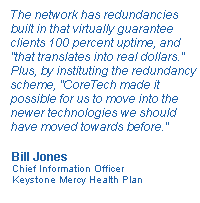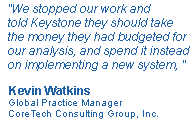
That was the problem at Keystone Mercy Health Plan, where an overtaxed network infrastructure paralyzed the company’s ability to process insurance claims on a daily basis. Keystone Mercy Health Plan, a joint venture between Mercy Health System and Independence Blue Cross, is the largest health insurance provider for Medical Assistance recipients in Pennsylvania. Formed in 1996, Keystone Mercy helps nearly 240,000 people in the five-county region of Southeastern Pennsylvania access quality health care services. Together with its family of health plans, Keystone Mercy is the largest managed care provider for Medical Assistance recipients in Pennsylvania and the largest multi-state Medicaid managed care provider in the nation with nearly 600,000 members in five states. The Challenge Keystone estimated that it lost approximately one million dollars for every day of downtime. Obviously, decisive action needed to be taken to rectify this unacceptable state of affairs. In the spring of 1998, Keystone Mercy brought in CoreTech Consulting Group to conduct an evaluation. What impressed CIO Jones was CoreTech’s superior ability to make new technology work for its clients, maximizing business benefits while minimizing disruption and risk. The CoreTech approach also takes into careful consideration the impact of new technology on the organization, its people and its processes. In other words, any time any system or application is introduced for the first time, it’s a "new" technology to the people who must use it and the organization that must assimilate it. CoreTech excels at facilitating the implementation of technology and helping companies deal with the effects of technology change. This was exactly what Keystone Mercy needed. The CoreTech Response "CoreTech presented us with a plan to not just upgrade but to replace our entire network environment. It included hardware, software and a topology plan," said Jones. "They helped us recognize that we had to make both strategic and immediate tactical changes." In April 1998, CoreTech and Keystone Mercy began working together to design and implement a network infrastructure that would possess the reliability, performance and capacity required to support Keystone Mercy’s current business needs as well as meet its future requirements. After weeks of tracing cables, applying tactical fixes, developing processes, designing the network, planning the migration, and ordering and receiving new equipment, the Keystone Mercy-CoreTech team was ready for the upgrade. They worked around the clock to get the new network running and stabilized. A Better Way of Working CoreTech’s focus on "knowledge transfer" also factored into Keystone Mercy’s decision to partner with the company. With every client engagement, CoreTech is aware of the need to share its technology expertise with the end-users who will be interacting with the IT systems every day. Keystone Mercy’s IT professionals worked hand-in-hand with CoreTech to design a network that would address all of the companies needs and issues and eliminate the frustration caused by excessive downtime. As a result, Keystone Mercy’s staff found the new network had all the features they wanted and they enjoy better performance at work now. This, in turn, boosted the employee retention rate. The enhanced expandability of the new network provides
support for up to 2,000 users, 240 servers and more than 80 remote locations. With 900
users, 80 servers and nine remote locations currently, the company is well positioned to
respond to future demands on the system. Instead of letting the network’s limitations
define its business decisions, Keystone Mercy can grow and evolve however it needs to in
order to Keystone Mercy has also seen its productivity skyrocket. The network has gone from an estimated 27 days of downtime per year to a few hours. The network has redundancies built in that virtually guarantee clients 100 percent uptime, and "that translates into real dollars," says Jones. Plus, by instituting the redundancy scheme, "CoreTech made it possible for us to move into the newer technologies we should have moved towards before." Moreover, transaction time was chopped in half and the company now boasts its lowest processing backlog in five years - which is as long as they’ve kept track of backlog numbers. Running the daily payroll reports, which used to take 30 minutes, now takes mere seconds. Ironically, the network moves so quickly, some employees thought it wasn’t operating properly at first. "Accustomed to waiting and watching while scanned images of incoming claims were processed, staff members were alarmed when they stopped seeing this slow progress on their screens," Jones recalled. "In fact, it was just that the images were processing too fast for them to see. The network speed was that much better!" A Future Full of Opportunity For example, Keystone Mercy can also look forward to high-speed Internet access, a new messaging system based on Microsoft Exchange, a more secure and reliable method of connecting to external business partners, and dial backup for all remote sites. "Already, we’ve seen a marked increase in the efficiency and reliability of the network for end-users throughout the company," said Jones. "But the biggest benefits are still to come, as we take advantage of our ability to implement new technologies as they develop. This will make us more competitive as we enter the 21st century."
CoreTech Consulting Group, Inc. excels in making new
technologies work for companies, maximizing business benefit while minimizing disruption
and risk. More information about CoreTech may be obtained by calling 800-220-3337 or via
the World Wide Web at: © 1999 CoreTech Consulting Group, Inc. All rights reserved. This case study is for informational purposes only. CORETECH MAKES NO WARRANTIES, EXPRESS OR IMPLIED, IN THIS SUMMARY. All products and company names mentioned herein may be the trademarks of their respective owners. 1/99
[ About CoreTech ] [ Services ] [ News &
Events ] [ Employment ]
|
|||||||

 Watkins, Global Practice Manager at
CoreTech.
Watkins, Global Practice Manager at
CoreTech. stay competitive - with full confidence that its
technology infrastructure is up to the challenge.
stay competitive - with full confidence that its
technology infrastructure is up to the challenge.